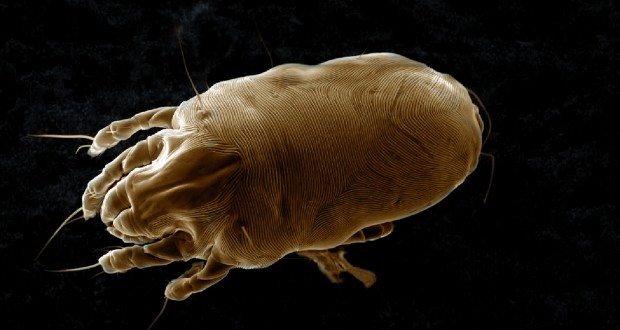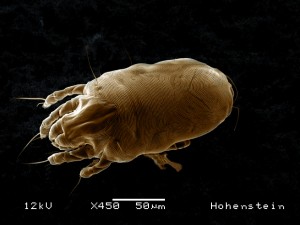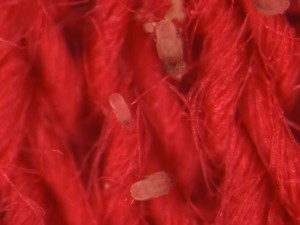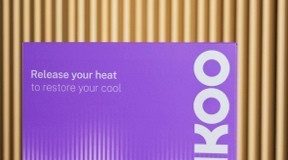BOENNIGHEIM – For some time now, people who are allergic to house dust have had the pleasure of knowing when the textiles around them offer proven and effective protection against dust mites. In future, patients suffering from neurodermatitis may also be pleased to find goods that are labeled in this way in the shops: it has been discovered that dust mites can also trigger neurodermatitis. German scientists tested neurodermatitis patients for dust mite allergy and found that 90% of sufferers were also allergic to dust mites, without realizing it. This has now also been confirmed
in a study from England which shows how dust mite allergens activate the immune system and trigger an inflammatory reaction in the skin. Children are most affected by neurodermatitis. They experience symptoms such as red flaky patches of eczema or severe itching. The two studies therefore show that preventing the skin from coming into contact with dust mite excrement, including via textiles, is an important way of counteracting neurodermatitis.
“These are two very important studies,” said Prof. Dirk Höfer of the William Küster Institute at the Hohenstein Institute, who is researching which kinds of clothing can help people with neurodermatitis or sensitive skin, “because they show a link for the first time – the fact that one and the same allergen can irritate both the respiratory tracts and the skin. They also show that suitable textiles could alleviate the symptoms of neurodermatitis.”
However, in addition to the effectiveness against dust mites, it is also important to take account of the special requirements that people with sensitive skin or eczema have of textiles, said Prof. Höfer. So as a supplementary measure to prevent and treat neurodermatitis, it is important to use infection-preventing yarns that are not cytotoxic and do not increase skin sensitivity (skin and tissue compatibility). Textiles should also not contain any mechanically irritating fibers, seams or accessories, should create a microclimate with the best possible textile physiological parameters such as thermal conductivity and moisture absorption and wicking, and should not have any occlusive (air-excluding) areas. Finally, they should also be compatible with treatments such as lotions.
Until now, manufacturers of bedding and encasings have mainly been interested in testing their products for “anti-dust mite effectiveness”, because textiles that successfully exclude dust mites and the allergens contained in their excrement (Der p1) can protect end users from the attendant symptoms of a house dust allergy. There is therefore a demand for these products, especially from healthcare institutions, hotels and guesthouses but also from private households. However, in the light of the new findings, the manufacturers and retailers of textiles that are specifically intended for neurodermatitis sufferers should also, in the interests of the consumer, attach increased importance to providing evidence that their textiles are “anti-dust mite effective”. But what exactly is meant by this?
To support this claim, the Hohenstein Institute offers two accredited tests. On the one hand, the “allergen-resistance of textiles” can be assessed, because bedding, for example, that effectively keeps the dust mite excrement at bay can be awarded the “House dust and dust mite barrier” label. On the other hand, the “Anti-dust mite effectiveness” test shows whether an item that has been treated actually inhibits the growth of house dust mites or even destroys them. Textiles tested in this way for compliance with the standard NF G39-011 can then be awarded the “Effective against dust mites” label. So this also identifies clothing that is beneficial for neurodermatitis sufferers.
The Hohenstein labels and certificates can be used by textile manufacturers in their marketing. They can successfully appeal to the target groups of “house dust allergy sufferers” and “neurodermatitis sufferers”, as well as healthy people who want to prevent neurodermatitis, and provide useful advice for them when they are buying textiles.
Dust mites feed on flakes of skin and moisture. In addition to mattresses and bedding, they therefore like to infest clothing and domestic textiles such as upholstered furniture and carpets. If these products are beneficial to neurodermatitis sufferers, they need to be labeled “Effective against dust mites”. © Hohenstein Institute
The way “anti-dust mite textiles” work is based on either the dust mites being destroyed by chemical agents (“anti-dust mite treatments”) or the textiles being so dense that no dust mite excrement can penetrate them. Textiles can be tested and assessed for both properties. © Hohenstein Institute
#AntiDustMite, #Textiles, #AgainstDust,
 SleepTech Magazine Mattress, Accessories, Machinery, Raw Materials
SleepTech Magazine Mattress, Accessories, Machinery, Raw Materials





